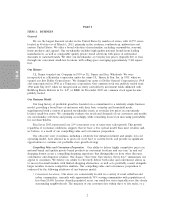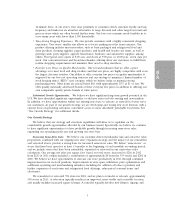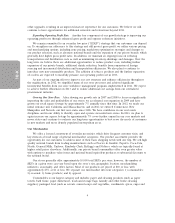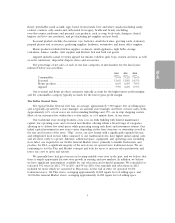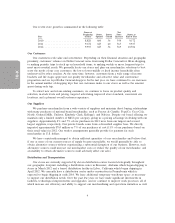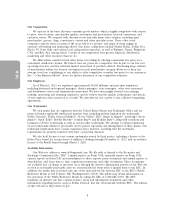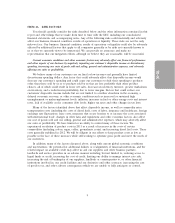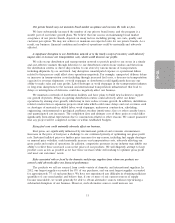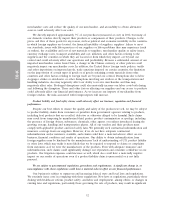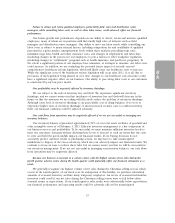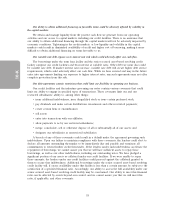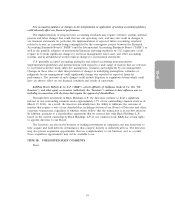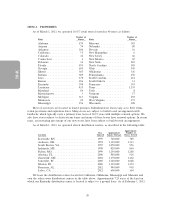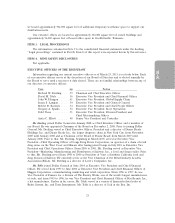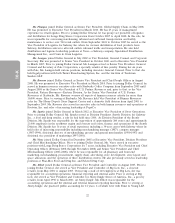Dollar General 2012 Annual Report Download - page 91
Download and view the complete annual report
Please find page 91 of the 2012 Dollar General annual report below. You can navigate through the pages in the report by either clicking on the pages listed below, or by using the keyword search tool below to find specific information within the annual report.
10-K
merchandise costs and reduce the quality of our merchandise, and an inability to obtain alternative
sources could adversely affect our sales.
We directly imported approximately 7% of our purchases (measured at cost) in 2012, but many of
our domestic vendors directly import their products or components of their products. Changes to the
prices and flow of these goods for any reason, such as political and economic instability in the countries
in which foreign suppliers are located, the financial instability of suppliers, suppliers’ failure to meet
our standards, issues with labor practices of our suppliers or labor problems they may experience (such
as strikes), the availability and cost of raw materials to suppliers, merchandise quality or safety issues,
currency exchange rates, transport availability and cost, inflation, and other factors relating to the
suppliers and the countries in which they are located or from which they import, are beyond our
control and could adversely affect our operations and profitability. Because a substantial amount of our
imported merchandise comes from China, a change in the Chinese currency or other policies could
negatively impact our merchandise costs. In addition, the United States’ foreign trade policies, tariffs
and other impositions on imported goods, trade sanctions imposed on certain countries, the limitation
on the importation of certain types of goods or of goods containing certain materials from other
countries and other factors relating to foreign trade are beyond our control. Disruptions due to labor
stoppages, strikes or slowdowns, or other disruptions involving our vendors or the transportation and
handling industries also may negatively affect our ability to receive merchandise and thus may
negatively affect sales. Prolonged disruptions could also materially increase our labor costs both during
and following the disruption. These and other factors affecting our suppliers and our access to products
could adversely affect our financial performance. As we increase our imports of merchandise from
foreign vendors, the risks associated with foreign imports will increase.
Product liability and food safety claims could adversely affect our business, reputation and financial
performance.
Despite our best efforts to ensure the quality and safety of the products we sell, we may be subject
to product liability claims from customers or penalties from government agencies relating to products,
including food products that are recalled, defective or otherwise alleged to be harmful. Such claims
may result from tampering by unauthorized third parties, product contamination or spoilage, including
the presence of foreign objects, substances, chemicals, other agents, or residues introduced during the
growing, storage, handling and transportation phases. All of our vendors and their products must
comply with applicable product and food safety laws. We generally seek contractual indemnification and
insurance coverage from our suppliers. However, if we do not have adequate contractual
indemnification and/or insurance available, such claims could have a material adverse effect on our
business, financial condition and results of operations. Our ability to obtain indemnification from
foreign suppliers may be hindered by the manufacturers’ lack of understanding of U.S. product liability
or other laws, which may make it more likely that we be required to respond to claims or complaints
from customers as if we were the manufacturer of the products. Even with adequate insurance and
indemnification, such claims could significantly damage our reputation and consumer confidence in our
products. Our litigation expenses could increase as well, which also could have a materially negative
impact on our results of operations even if a product liability claim is unsuccessful or is not fully
pursued.
We are subject to governmental regulations, procedures and requirements. A significant change in, or
noncompliance with, these regulations could have a material adverse effect on our financial performance.
Our business is subject to numerous and increasing federal, state and local laws and regulations.
We routinely incur costs in complying with these regulations. New laws or regulations, particularly those
dealing with healthcare reform, product safety, and labor and employment, among others, or changes in
existing laws and regulations, particularly those governing the sale of products, may result in significant
12


